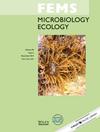Changes in nutrient availability substantially alter bacteria and extracellular enzymatic activities in Antarctic soils
IF 3.5
3区 生物学
Q2 MICROBIOLOGY
引用次数: 0
Abstract
In polar regions, global warming has accelerated the melting of glacial and buried ice, resulting meltwater run-off and mobilisation of surface nutrients. Yet, the short-term effects of altered nutrient regimes, on the diversity and function of soil microbiota in poly-extreme environments such as Antarctica, remains poorly understood. We studied these effects by simulating such environments via constructing soil microcosms through augmented carbon, nitrogen, and moisture supplements. Addition of nitrogen significantly decreased the diversity of Antarctic soil microbial assemblages, compared with other treatment groups. Other treatments led to shift in relative abundances of these microbial assemblages with random distributional patterns. Only nitrogen treatment appeared to show clear community structural patterns, with increase in abundance of Proteobacteria (Gammaproteobateria) and decrease in Verrucomicrobiota (Chlamydiae, Verrucomicrobiae). Effects of extracellular enzyme activities and soil parameters on changes in microbial taxa also showed significance impacts of nitrogen treatment. Microbial response to nutrient addition was predicted using structural equation modelling which revealed that nutrient source and extracellular enzyme activities were positive predictors of microbial diversity. Our study highlights the effect of nitrogen addition on Antarctic soil microorganisms which showed resilience to nutrient increases. Rather than being resistant to change, these microorganisms rapidly responded to augmented nutrient regimes.养分供应的变化极大地改变了南极土壤中的细菌和细胞外酶活性
在极地地区,全球变暖加速了冰川和地下冰层的融化,导致融水径流和地表养分的调动。然而,在南极洲等多极端环境中,养分制度的改变对土壤微生物群的多样性和功能的短期影响仍然知之甚少。我们通过添加碳、氮和水分补充剂构建土壤微生态系统,模拟此类环境,研究了这些影响。与其他处理组相比,氮的添加明显降低了南极土壤微生物群落的多样性。其他处理导致这些微生物群落的相对丰度发生变化,并呈现随机分布模式。只有氮处理似乎显示出明显的群落结构模式,蛋白细菌(Gammaproteobateria)的丰度增加,而蛭弧菌群(衣原体、蛭弧菌)的丰度减少。细胞外酶活性和土壤参数对微生物类群变化的影响也显示了氮处理的显著影响。利用结构方程模型预测了微生物对养分添加的反应,结果表明养分来源和细胞外酶活性是微生物多样性的正向预测因子。我们的研究强调了氮添加对南极土壤微生物的影响,这些微生物对养分的增加表现出很强的适应能力。这些微生物不仅不会抵制变化,反而会对增加的养分制度迅速做出反应。
本文章由计算机程序翻译,如有差异,请以英文原文为准。
求助全文
约1分钟内获得全文
求助全文
来源期刊

FEMS microbiology ecology
生物-微生物学
CiteScore
7.50
自引率
2.40%
发文量
132
审稿时长
3 months
期刊介绍:
FEMS Microbiology Ecology aims to ensure efficient publication of high-quality papers that are original and provide a significant contribution to the understanding of microbial ecology. The journal contains Research Articles and MiniReviews on fundamental aspects of the ecology of microorganisms in natural soil, aquatic and atmospheric habitats, including extreme environments, and in artificial or managed environments. Research papers on pure cultures and in the areas of plant pathology and medical, food or veterinary microbiology will be published where they provide valuable generic information on microbial ecology. Papers can deal with culturable and non-culturable forms of any type of microorganism: bacteria, archaea, filamentous fungi, yeasts, protozoa, cyanobacteria, algae or viruses. In addition, the journal will publish Perspectives, Current Opinion and Controversy Articles, Commentaries and Letters to the Editor on topical issues in microbial ecology.
- Application of ecological theory to microbial ecology
- Interactions and signalling between microorganisms and with plants and animals
- Interactions between microorganisms and their physicochemical enviornment
- Microbial aspects of biogeochemical cycles and processes
- Microbial community ecology
- Phylogenetic and functional diversity of microbial communities
- Evolutionary biology of microorganisms
 求助内容:
求助内容: 应助结果提醒方式:
应助结果提醒方式:


